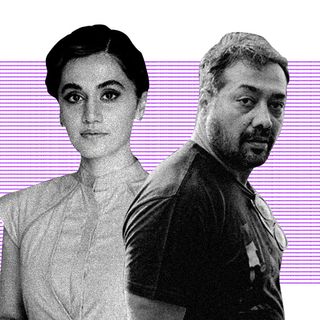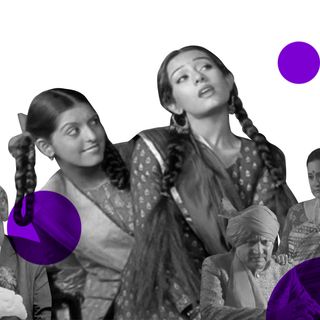
Tell Me More: Talking Muslim Identity In India With Ghazala Wahab
“If you live with prejudice that’s so commonplace, to the point where people aren’t even aware of how irrational their bias is, it threatens all aspects of your life.”

In The Swaddle’s interview series Tell Me More, we discuss crucial cultural topics with people whose work pushes societal boundaries.
Ghazala Wahab is executive editor of Force Magazine, where she writes on homeland security, terrorism, Jammu and Kashmir, left-wing extremism, and religious extremism. She is the author of Born a Muslim and Dragon on Our Doorstep: Managing China through Military Power with Pravin Sawhney. She contributed a chapter on the changing profile of terrorism in Jammu and Kashmir in the book Operation Parakram: The War Unfinished. A career journalist, Ghazala has worked with The Telegraph and Asian Age. The Swaddle’s Aditi Murti spoke with Ghazala about the evolving trajectory of Muslim identity in India, amid rising communal violence and biased legislation.
The Swaddle: In one part of your book Born A Muslim, you write about a lower caste Muslim individual who works with leather tanneries, and actually wants to change his name to a Hindu one. There was also another story about a middle class Muslim woman who was worried about the aggressive assertion of Muslim identity in spaces like Shaheen Bagh. Has there always been a history of fear with respect to asserting a Muslim identity, or is it a more recent phenomenon?
Ghazala Wahab: This identity crisis is a very recent phenomenon. Muslims didn’t worry about asserting their identity all these years since Independence– even if you look at Muslims looking or behaving in a stereotypical manner in films and popular media, there wasn’t much protest against that. By and large, Muslims felt comfortable with their identity and knew when something was an exaggeration. What’s happened over the past few years is that this Muslim identity and appearance is being used to target them. Previously, nobody would really bother to look at a Muslim woman in a full burqa, or men in checked lungi or ankle-high pants — it was just a part of the landscape. Now, this exact identity has become a reason for insecurity, because Muslim people are being heckled in transportation, and in more extreme cases, being lynched and killed. This is why educated, middle class Muslims are a bit put-off by being assertive. For example, if Muslims are in a public spaces, they don’t want to say As-salamu alaykum, they’d rather say namaste.
The Swaddle: Even so, a middle class Muslim might still have to deal with bias in everyday life, right?
GW: So a lot of middle class Muslims grow up in Muslim-dominated areas. That’s quite different from a ghetto. For example, in Bombay, think Mohammed Ali Road or Bhindi Bazaar — even super rich Muslims prefer to live in these areas because there’s an inherent sense of security in that environment. They don’t engage with non-Muslims on a daily basis, because all their grocery shopping, and even employment, occurs within the same area. It’s not commonplace for them to frequently go out and engage with people who are different from them. The people who do experience bias are migrants, who move to the city, and have to figure out employment and schooling for their children. There, they’d experience trouble finding accommodation, because of the way they look. There’s both the insider-outsider bias, and religious pressure at work. While its normal for people to feel comfortable among their own communities within big cities, but the more worrying flipside to this is when people group together because they’re hostile to another set of people. That particular outsider now is the Muslim — and this leads to trouble finding work, or even getting paid the same amount as a non-Muslim. This leads to a particular disillusionment with the system, and that has a cascading effect on your psychology. You feel like there’s no point in trying, and your connection outside your own community frays, because why should you be fair to others if society hasn’t been fair to you?
TS: Is the root of the hostility towards the Muslim identity in India rising from religion, or the identity itself?
GW: Neither. There’s no basis to prejudice. In India, this particular bias has been carefully cultivated based on myths. For example, the earliest myth was that “Muslims will always be with Pakistan,” and the vague reasoning for that was that Muslims always cheered for Pakistan during cricket matches between India and Pakistan. There’s no empirical evidence for the same, but so many people in Bombay quoted this one particular incident where firecrackers went off in a Muslim area when Pakistan won one cricket match. Even if it were true, you’ve built a larger allegation out of one isolated incident.
The second type of prejudice comes from history — that Muslims have pillaged India for centuries, destroyed our temples, raped our women, and forced conversions of our forefathers by threatening death. The third myth is that there’s widespread appeasement of Muslims in India — Muslims allegedly receive more government subsidies from successive governments, they can marry several times, and give talaq (divorce) to their wives by saying it thrice. The most recent mythical narrative is Hindu khatre mein hai — that the Muslim population is growing so fast that it will soon overtake Hindus. If you see all of these myths in a dispassionate way, you’ll realize that none of this has any basis in fact, but this narrative is so widespread that people simply don’t question it anymore. They have assumed this is true. If you tell them it’s not true and try to back it up with proof, they’ll say — oh this is motivated writing done by ‘left-liberal’ historians. Anything prejudiced people feel distrust for is ‘left-liberal.’
TS: In a previous interview, you’d said the Muslim votebank is pretty much rubbish. Could you explain why?
GW: According to the last census in India, Muslims are about 14 percent of the total population, but the Muslim representation in both Houses is less than 8 percent. Muslim representation in the parliament has never exceeded 10 percent, except once in 1980, when it was close to 11 – 12%. Since then, this percentage has been progressively diminishing. Very few parties field Muslim candidates anymore — it’s only done sporadically by left parties and Congress.
The only two union territories in India where you must field a Muslim candidate are Jammu and Kashmir, and Lakshwadeep, where the populations are overwhelmingly Muslim. Here, even the BJP has to field a Muslim candidate. Everywhere else, Muslims vote according to the candidate they feel is most likely to defeat the BJP.
In the last election, there was this big story about Deoband, UP, a Muslim majority area, because a non-Muslim BJP candidate had won the election. The truth was that the BJP candidate had won because there were atleast six to seven Muslim candidates in the fray. So all the Muslim votes were divided among these candidates, while the Hindu votes consolidated in favor of one candidate, making all the Muslim votes irrelevant. This is what is happening in places where a Muslim vote can have influence on the outcome of an election result. They field several Muslim candidates — the BJP too fields several dummy candidates and the vote gets divided. So the Muslim vote bank doesn’t really exist.
TS: There’s not much that we know about hierarchies in Muslim society because its always assumed to be ‘classless.’ Does marginalization play out differently when it comes to hierarchies in Indian Muslims?
GW: There are three broad categories of caste among Muslims in India. One is the upper class, which is made up of people who ostensibly came from Arabia or Iran or Turkey or Central Asia. Many of these people also claim to be direct descendants of the Prophet, but there’s no real way to verify that of course. This group also includes upper caste Hindus who coverted to Islam for a variety of reasons. Then you have the working class, made up of skilled individuals like weavers and carpenters and artisans. The third group of people are lower caste Hindus who converted to Islam — they are called Pasmanda Muslims. The peculiarity of Muslim caste hierarchy is that there’s no untouchability. The only way caste comes to the fore is during marriage, as each caste wants to intermarry within their group. The only way to step out of one group is to marry into a caste above your current one, as marrying into a caste below yours is looked down upon.
TS: Is a lower caste Muslim at greater risk for communal violence?
GW: Absolutely, because a lower caste Muslim is almost always a poor Muslim. Wealth isn’t limited to the upper caste, but it does converge around it. Upper caste Muslims have a history of privilege, so they also are likely to have more land, be better educated, and find more acceptability in the mainstream. What adds to acceptability is their lighter complexion, better physical attributes and command over their language, be it Urdu or English. All of these opens more doors for them.
TS: I wanted to talk about Muslim women in particular, because their specific identity was a topic of national discussion due to Shaheen Bagh and the Triple talaq political charade. How did this affect Muslim women’s agency and perception in India?
GW: It further reinforced prejudice. When this whole Triple talaq debate was going on, you only saw images of Muslim women huddling together, and in extreme poverty. This imagery was reinforced again and again, and the perception became that of a Muslim woman being someone completely at the mercy of men — impoverished, beaten, with no agency over her life. Now, irrespective of religion, any woman in India would deal with similar situations. There are only certain groups of women, regardless of religion, who are progressive and educated. Many others are victims of patriarchal structures, and mistreated by their husbands and their families. Treating women badly is not a religion problem, it’s a nation-specific problem. But due to the triple talaq imagery playing out frequently on television screens, people started believing that this is how a Muslim woman looks, further diminishing people’s understanding of the community.
TS: Overall, there’s an incurred risk of being a Muslim individual in India. Could you tell us about how this prejudice affects the everyday life of Muslim people in India?
GW: The biggest threat to Muslim people is the constant threat of marginalization. Prejudice these days is so pervasive that the average Muslim has trouble finding employment. There’s research from the Economic Times which states that the take-home salary of a Muslim individual is less than that of a non-Muslim, because the Muslim’s capacity to negotiate a better pay package is much lesser due to prejudice. You already have prejudice against Muslims in both the armed forces and law enforcement. For years, intelligence agencies have been wary of hiring a Muslim because they felt that the identity divided a Muslim individuals’s loyalty to India. This prejudice is so pervasive now that the average individual believes they’re better off without a Muslim person around them. Another recent example from the pandemic was a rumor about Muslim vendors spitting on the vegetables they were selling, leading to vendors being removed from housing societies and areas where they have been selling for years. If you live with prejudice that’s so commonplace, to the point where people aren’t even aware of how irrational their bias is, it threatens all aspects of your life, everyday.
Aditi Murti is a culture writer at The Swaddle. Previously, she worked as a freelance journalist focused on gender and cities. Find her on social media @aditimurti.
Related


AI Analysis of 700 Bollywood Films Finds Many Societal Biases Have Changed, But Fairness Still Signals Beauty
